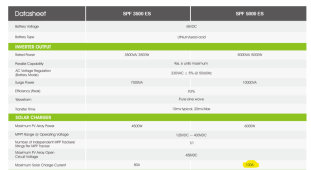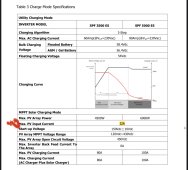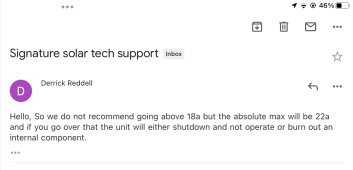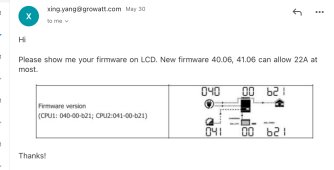carpediem80
New Member
- Joined
- May 17, 2022
- Messages
- 8
I have the following components and i would appreciate your feedback on best configuration for my panels:
- 2 Growatt SPF 5000 ES (europe and will use it at 240V)
- 20 550W panels
- Voc = 50.32V STC and 48.1V NOCT
- Isc = 13.92A STC and 11.07A NOCT
- Vmpp = 42.28V STC and 39.9V NOCT
- Impp = 13.01A STC and 10.45A NOCT
- Max series fuse rating 25A
- Temperature coefficient for Voc is -0.28%/deg C
- Temperature coefficient for Isc is +0.05%/deg C
- 1 LifePO4 51.2 V 200ah battery
- If i use 10s on each inverter then i exceed Voc max of inverter ( 503.2V vs 450V)
- if i use 5s2p on each inverter then Isc reaches 27.84A
Growatt SPF 5000 ES has max PV input current at 22A.
Should i just ignore 2 panels and use
8s on each inverter?
Many thanks for all your help
- 2 Growatt SPF 5000 ES (europe and will use it at 240V)
- 20 550W panels
- Voc = 50.32V STC and 48.1V NOCT
- Isc = 13.92A STC and 11.07A NOCT
- Vmpp = 42.28V STC and 39.9V NOCT
- Impp = 13.01A STC and 10.45A NOCT
- Max series fuse rating 25A
- Temperature coefficient for Voc is -0.28%/deg C
- Temperature coefficient for Isc is +0.05%/deg C
- 1 LifePO4 51.2 V 200ah battery
- If i use 10s on each inverter then i exceed Voc max of inverter ( 503.2V vs 450V)
- if i use 5s2p on each inverter then Isc reaches 27.84A
Growatt SPF 5000 ES has max PV input current at 22A.
Should i just ignore 2 panels and use
8s on each inverter?
Many thanks for all your help







